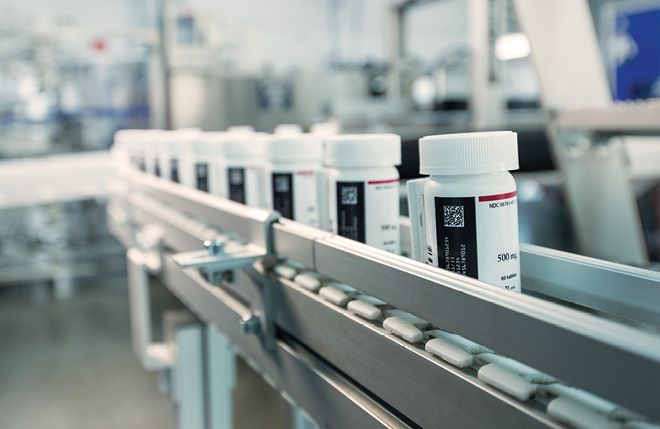Serialization status in ‘Year Zero’
The looming November 2017 deadline for US pharma serialization drives rapid implementation
Serialized, barcoded bottles on the march toward DSCSA compliance. Credit: PCI

Although the Drug Supply Chain Security Act (DSCSA) was passed in 2013 and has implementation milestones that have already been achieved, 2017 can be considered “Year Zero” for the law’s fundamental requirement: to put a unique identification code on each pharmaceutical package coming off the industry’s packaging lines. That is due to be a national requirement on November 27. Other deadlines, involving the downstream trading partners of pharma such as wholesalers and pharmacies, will follow, culminating in a 2023 date when tracking a drug’s journey from point of manufacture to point of dispensing is supposed to be all-electronic and verifiable by FDA inspectors and others.
The upshot is that pharma manufacturers have been energetically evaluating existing packaging lines and strategizing how new lines will accommodate the serialization requirements. This has been a boon to a growing number of packaging and automatic identification and data capture (AIDC) vendors marketing barcoding systems (the preferred technology for marking), machine-vision systems and cartoning/palletization machinery. On the heels of this hardware installation, IT systems to manage the flow of data to and from packaging lines, and thence to enterprise or even national data repositories, is proceeding apace.
Much of the current activity has shifted to contract manufacturing and packaging organizations (CMOs), many of whom lack the resources to develop full-blown systems capable of handling the differing requirements of multiple clients. In a survey of industry readiness published in late 2016, the Healthcare Distribution Alliance found that roughly one-third of respondents will not be ready in November. In all likelihood, FDA will not shut off unprepared manufacturers; past DSCSA deadlines with less than 100% compliance saw FDA extending the deadline by five- or six-month periods, but also looking for indications of progress in meeting the requirements. (However, given all the turmoil and misdirection in Washington, DC these days, it’s hard to say what FDA’s policy might be by then.)
Last fall, a market research firm, MarketsandMarkets, estimated this hardware/software capital investment at $1.27 billion, rising at a 17.3% clip to $2.81 billion in 2021. Most observers see this as an underestimate: operational costs and the need for continuing technical upgrades could add billions more. But even that growth estimate is generating substantial activity among vendors chasing the market; here’s what some of the industry players are experiencing:
Aggregation of items in cartons is touted by PCI

TraceLink announced a 108% increase in sales bookings for 2016 over 2015, and counts 530 customers, which it claims is “the largest customer base and track and trace network in the industry.” More than 150 million serial numbers were commissioned running through TraceLink systems in the year, double the previous year. The company also touts a “proven” solution for compliance with the EU’s Falsified Medicines Directive (FMD), the European counterpart to DSCSA. Tracelink’s core capability is enterprise-level data transfer (i.e., taking serial data and events from a packaging line or site, and conveying them to an enterprise repository and thence to trading partners); unusual for companies in this field, it says that 60% of those 530 customers include dispensing sites, such as pharmacies and hospitals.
Optel Vision, which provides hardware and software for packaging line serialization, claims a leading, 25.7% share of that portion of the market. The company has doubled office space at its Quebec City, Quebec headquarters, and now has operational centers in Canada, Ireland, India and Brazil, and is reaching a headcount of 1,000. Addressing the CMO market, Étienne Gagnon, president, says that “We've also recently developed lower-cost, entry-level solutions for smaller companies that just need to meet their compliance deadlines quickly and at an affordable cost.”
A pioneer in the pharma serialization field, Systech International, which offers both machine-vision systems and enterprise-level software, announced a “Serialized by November” program, which it claims can get basic DSCSA compliance in place in 90 days. This includes “multi-level serialization,” site and line management configuration, a built-in foundation for future lines, Factory Acceptance Testing (FAT), and Site Acceptance Testing (SAT). Systech is currently onboarding customers from now until August 1, 2017. The company also claims 1,600 existing implementations (which could include multiple packaging lines at some clients), said to have “65% more lines than its next largest competitor.”
With not much fanfare at the end of 2016, SAP took the wraps off version 2.0 of its Advanced Track and Trace for Pharma (ATTP) software, which was introduced in late 2015. The company touts its close integration with other SAP products (which are widely used in the life sciences industry); the technology has been deployed at a number of pharma multinationals.
Adents, a French AIDC vendor, has taken several steps to expand its marketing in the US, including having its CEO, Christophe Devins, transferring to the US to run the American operation. “This is the ideal time to strengthen our US presence, as we work to bolster Adents’ bandwidth to accommodate accelerated demand for our serialization software solutions,” he said in a statement. A year ago, the company announced a collaboration with Microsoft for a Level 4 (i.e., enterprise-level) cloud-based traceability solution, branded as Prodigi. The company says that Prodigi will enable other Microsoft tools, such as Power Business Intelligence, to integrate with the serialization data. Additionally, Adents markets Seriza, a site-level serialization data-management system; it also works with a consulting firm, Supply Chain Wizard, to integrate the latter’s operational effectiveness software with Adents’ tools.
Machine-vision and packaging technology developer Antares Vision has moved to a larger US headquarters in Moorestown, NJ, quadrupling its warehouse space. The Italy-based company provides both hardware and software for serialization, and has just introduced a labeling machine specifically for bottled products, the Omnivision 360° bottle tracking system. It offers both serialization and aggregation (the step of verifying the identities of multiple bottles packed into a carton) at speeds up to 250 items/minute. The company also offers aggregation and palletization machinery for cartons, bundles and pallets. The aggregation topic has been a sore one for many industry participants: it is not required by DSCSA; nevertheless, for practical inventory handling, most leading wholesalers want aggregated, verified cartons to be delivered to them by manufacturers.
Among CMOs, PCI has made its serialization capabilities a key message in competing for business; the company has hosted serialization-readiness seminars around the country in the past 12 months, and most recently announced a tripling of its serialization-ready packaging lines, specifically to meet both DSCSA and FMD deadlines. This is in conjunction with capacity expansions at its Philadelphia, PA and Rockford, IL, sites, where blister packaging, bottling and pouch/sachet filling technologies are being implemented. The company notes that “PCI has strongly supported the advanced use of aggregation to realize significant benefits in packaging operations as well as the broader pharmaceutical supply chain.”
There are two industry-standardization efforts that are key to the successful industry-wide implementation of DSCSA. One is the EPCIS standard from the GS1 organization, a version 1.2 of its requirements was published in the fall. EPCIS will enable the data on serialization “events” (not just ID numbers, but the status of a package’s disposition) to be communicated among trading partners. It’s not a DSCSA requirement, but in practice, most vendors, and most customers, are looking for it. Verify Brand, another AIDC software vendor, urges not just strict EPCIS compliance, but version 1.2 compliance (see p. xx), but the reality is that many implementations will remain in version 1.0—or even systems not fully EPCIS-compliant.
The other is the Open SCS (Serialization Communication Standard) Group, a vendor-originated effort to enable a common, open communication standard, initially at the packaging line level (which is not covered by GS1). Only relatively late in the day (given the 10+ years that traceability has been an issue in the US) did vendors realize that interoperability among the machine-vision systems, the aggregation solutions and the enterprise-level data managers would benefit pharma customers. Pharma execs kicking the tires of serialization solution providers should inquire about Open SCS before taking out their checkbooks.
Save
